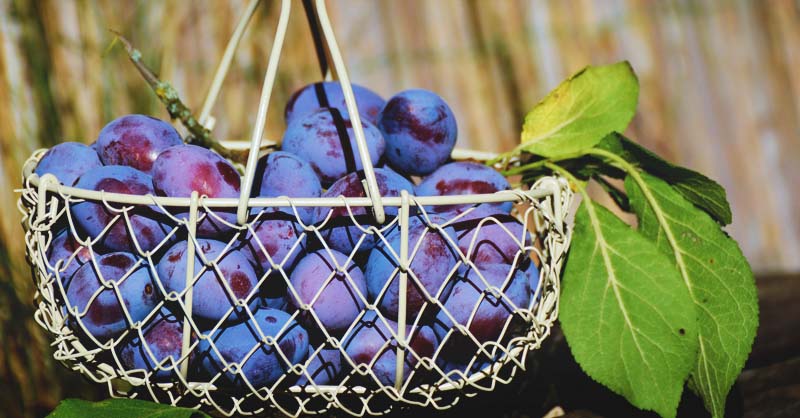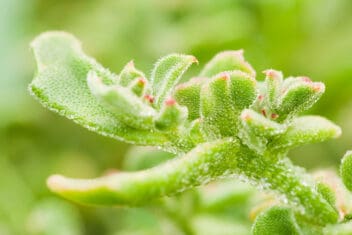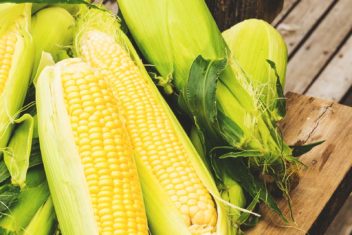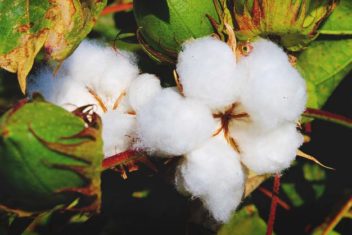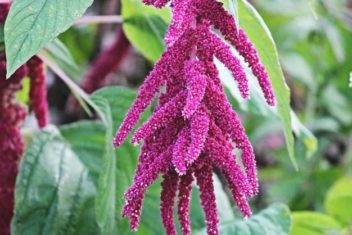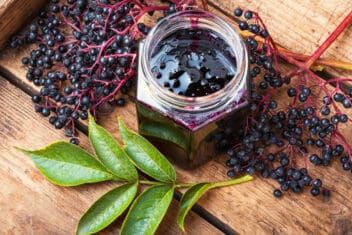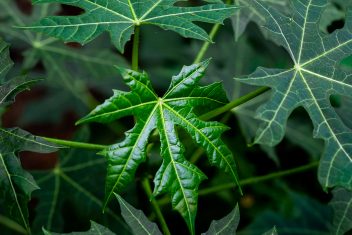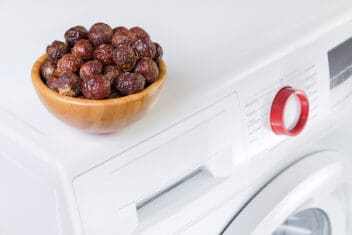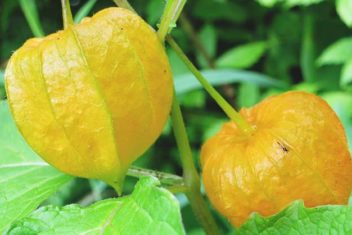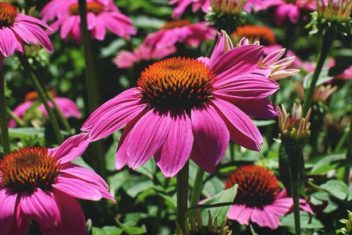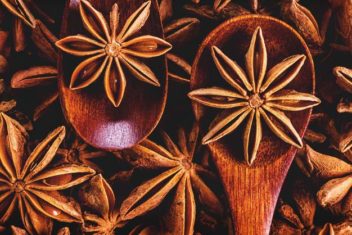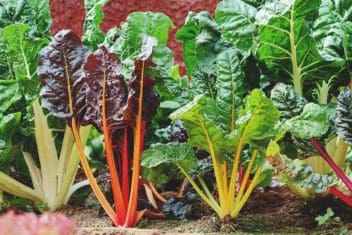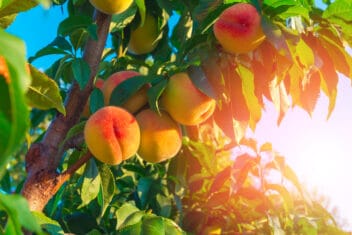Plums are my favorite fruits to eat, so it’s lucky that they’re one of the easier fruit trees to grow. Growing plums doesn’t require as much work as, say, apples or cherries. There are also many different types of plums that take to a wide variety of climates, so there’s likely one that will thrive in your space.
They’re hardy and productive, providing a bountiful harvest even on dwarf trees. As if that’s not enough to love, let’s not forget how gorgeous they look and smell in the spring when they have all their pretty white and pink blossoms.
Like peaches and apricots, plums are stone fruits – also known as drupes. They’re delightful fresh off the tree, used in savory recipes, or baked into desserts.
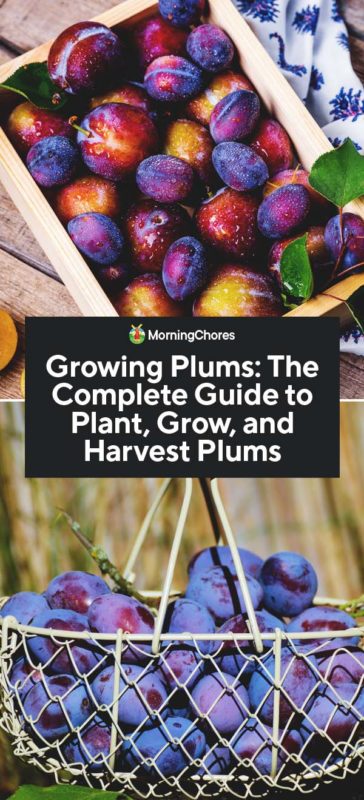
Plum Varieties
There are tons of plum varieties to choose from. Plums are typically categorized by European, Japanese, hybrid and American types. Each has its advantages.
European Plums
European plums grow well in a variety of soils, including heavy clay. They are oval shaped and have soft skin and sweet flesh. They’re popular for eating fresh and using in preserves.
Unfortunately, they’re not as cold hardy as hybrid varieties. European plums also don’t live as long as other types. On the bright side, they’re resistant to brown rot, black knot, and funguses. They grow best in zones 4-8.
European plums are self-fertile. However, planting another variety will improve your pollination rates and is also a smart way to expand your harvest dates. Here are a few types to watch for:
- Stanley – Stanley is perhaps the most well-known of the European types. It is a multipurpose plum that’s delicious fresh or canned. They’re medium-to-large oval fruits with yellow flesh that’s incredibly sweet. This is the plum that is typically dried to make prunes. Stanley is a highly productive tree that usually starts bearing in three years.
- Green Gage – This type is ideal if you’re looking to make plum pudding and preserves because this sweet plum is the queen of desserts. Green gage, sometimes called Reine Claude, has yellow-green skin and is semi-freestone. This type came from Armenia over 500 years ago. It’s not as long-lived as some others.
Japanese Plums
Japanese plums are round. They’re popular in savory cooking. The Japanese plum is not as cold hardy as some varieties – it does well where peaches grow.
- Methley –Methley is probably the most popular of the Japanese varieties. It’s a compact, upright tree making it perfect for small yards. Dwarf sizes grow to 8 – 10 feet. Methley has medium-sized fruits with juicy red flesh making them great for fresh eating. It does well in zones 6-9.
- Shiro Plum – Shiro plums are a beautiful yellow color which looks lovely next to their olive green leaves. They are highly productive but sensitive to cold. They do best in zones 6-9.
Hybrid Plums
Hybrid plums are a cross between Asian and American species. They’re hardy and tolerate the cold well. Hybrid plums need a friend for pollination. Watch for the following cultivars:
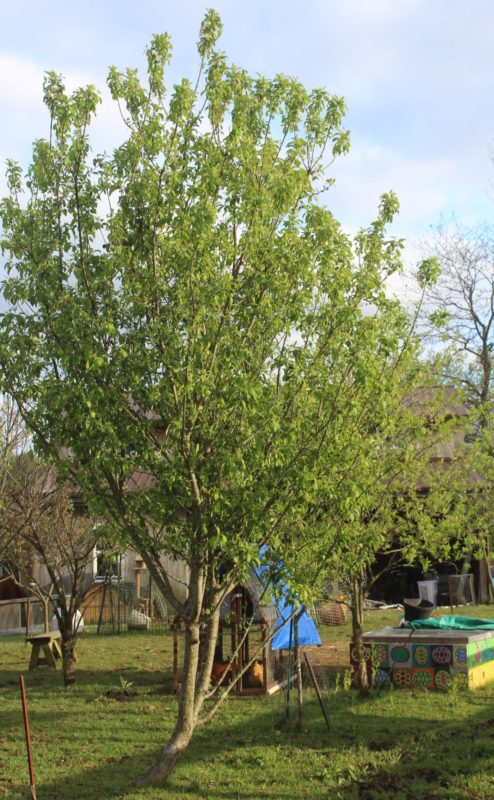
- South Dakota – South Dakota is one of my favorite plum trees. Mine is a beautiful and hardy tree that produces well and is only six years old. The fruit is on the smaller size but the taste is exquisite. The skin is a yellow/red blush with juicy and sweet yellow flesh. It’s a true freestone, meaning the flesh doesn’t cling to the pit, which makes things easy during canning season. It has a long bloom time which makes it a good pollinator for other hybrid plums. Does well in zones 3-8.
- Pipestone – Pipestone is another excellent and hardy variety. The skin is a rich red color with thick yellow flesh. This clingstone has an excellent fresh eating flavor that will delight your family.
- Bruce – I picked up this tree as a small sapling at Tractor Supply during the end of year discounts, and I’m glad I did. It produces slightly tart juicy fruit which is ideal for making jam.
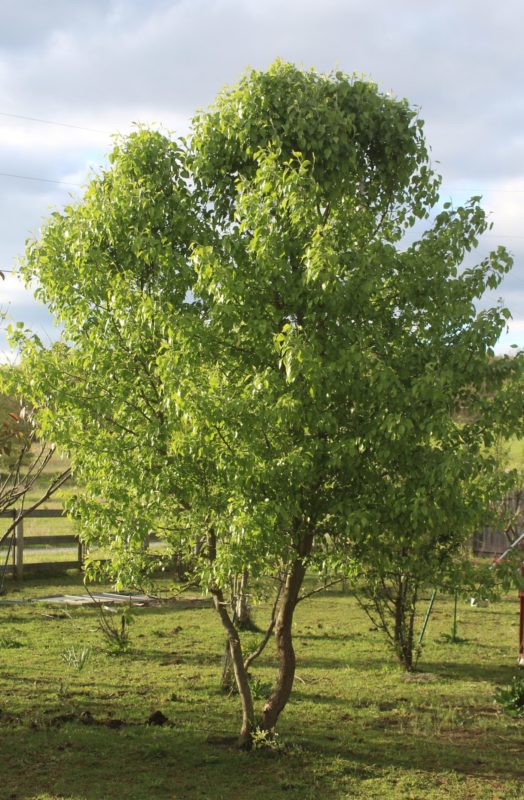
American Plums
American plums, also called wild plums, are native to wood thickets all over the United States. They’re an excellent pollinator for hybrid plums. They’re also quite hardy and thrive throughout the continental United States.
As well as being an excellent pollinator, the American plum is a beautiful landscaping tree with showy white flowers in spring and deep red fall foliage.
Planting Plums
Zones
Although you can find plums that will grow in a variety of ranges, plums generally do well in zones 3-10.
Sun Requirements
Plums need a location in full sun, with about 6-8 hours of direct light per day.
Soil Requirements
Give plums sandy, loamy soil with a pH between 5.5-6.5. Well-drained fertile soil is optimum, but plums are pretty tolerant. Work in some compost before planting.
Getting your young tree off to a good start is essential. Check out my soil mixture for planting new fruit trees.
Spacing
The traditional spacing is 10-20 feet apart for dwarf trees and 15 feet apart for semi-dwarfs. Give standard trees 20-25 feet of space. Don’t plant trees more than 50 feet apart so that they can cross-pollinate.
Cluster Planting
Fedco recommends planting a cluster of plum trees to improve pollination and yield and works exceptionally well for hybrid and American varieties. A cluster means you plant your trees closer together than usual. For a bunch, plant trees 3-6 feet apart so that the branches are touching. In addition, plant one American plum for every four hybrid plums to give yourself the most production.
Putting Plums in the Ground
Plums do best in a sheltered location, facing south or southwest. I have mine in the middle section of my orchard so that they get protection from apples and pears on either side.
This video will give you everything you need to know about digging the perfect planting hole for plums.
When planting, remember to pay attention to the graft. Most fruit trees that you purchase, weather balled and burlap or bare root will be grafted. The graft union will be a bump on the bark. It’s important to plant your tree with that graft union about one inch above the soil line.
Pollination
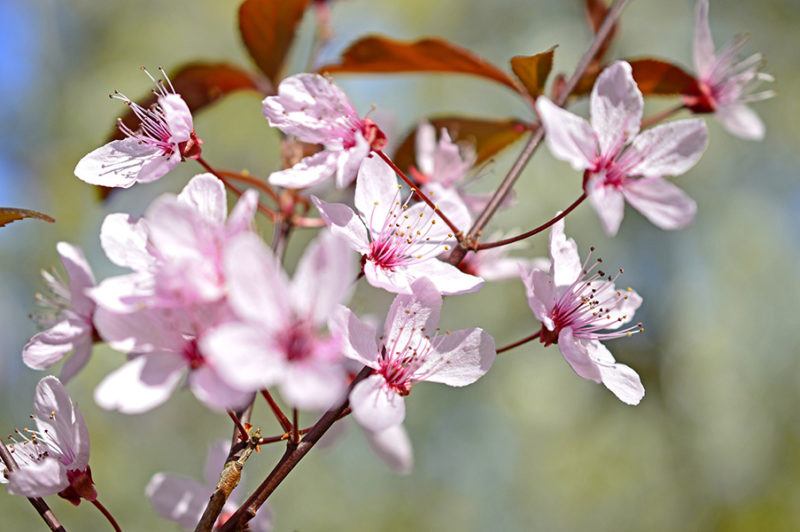
Pollination is key with plums. Make sure you look at the bloom times with the varieties you are planting to ensure they’re compatible. Washington State University has a handy pollination chart.
Having bees is a great advantage with plums. If you are not a beekeeper, you can encourage native bees into your orchard by providing housing and a shallow dish of water.
Caring For Your Plums
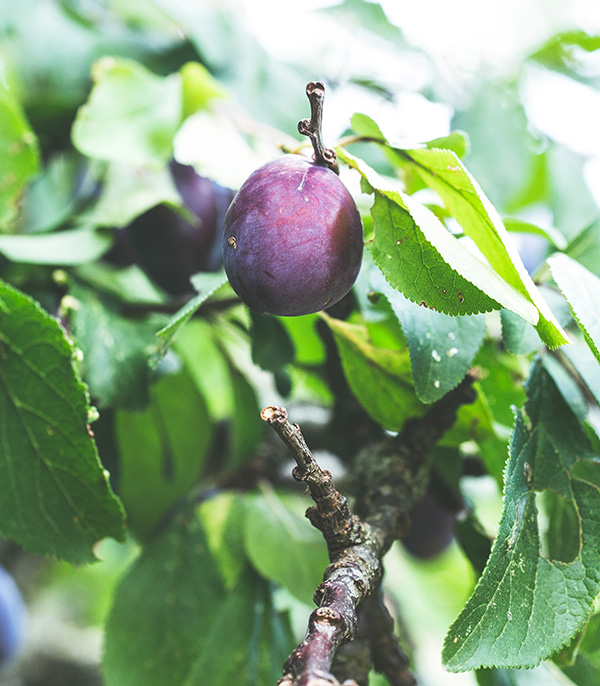
Fertilizing Your Plums
Plums have a high nitrogen need and benefit from fertilization. In the fall I spread a thick layer of organic compost around my trees. In spring I spray newly emerged leaves with fish emulsion.
You can gauge the health of your tree by its growth. A young plum tree should be adding 3-4 inches of new green growth every year during the growing season.
Watering
Your growing plums need about an inch of water each week during their first two seasons. If mother nature doesn’t bless you with that, give them a thorough soaking with the hose. It is better to provide a deep watering every ten days or so than short, shallow waterings.
Pruning
Pruning stimulates your tree to grow and helps shape your tree to benefit fruit production.
European plums are an upright tree and use the central leader method of pruning. A central leader will have one strong trunk up the center and be in the shape of a pyramid. Prune to encourage lateral branches off the sides.
Japanese plumes should be pruned in a vase shape. Pick three main scaffold limbs to encourage a full upright shape.
Spraying Plums
Put your plum trees on a regular organic spray schedule, with a minimum of three applications per year. Popular times to spray are in late winter during dormancy, in spring when buds appear and summer when the fruit is forming. Some good organic sprays include Surround, neem-based sprays, and Spinosad.
Plum Problems and Solutions
Crown Gall
Crown gall is caused by the bacterium Agrobacterium tumefaciens and impacts numerous fruit trees. You’ll notice wart-like bumps – called galls – on the tree roots and crown. These galls can slow growth by limiting the water and nutrients that the tree can access.
The disease enters the tree through wounds in the tree, so the best way to prevent gall from taking hold is to use extreme care when working with your plums.
Bacterial Canker
Bacterial canker usually shows up in the spring when you’ll notice limb dieback and cankers on your tree. You may also see an amber-colored sap. It’s spread by water and is particularly common in areas of your garden where water pools.
This bacteria likes to attack stressed trees, so maintaining tree health is essential. Keep your tree well watered and fed, and be sure to keep nematodes under control.
Powdery Mildew
Powdery mildew is the blanket term for various fungi that attack the fruit and leaves of growing plums. You’ll see areas of powdery white fungal growth on fruit in the spring, moving onto the leaves in the summer.
Spray trees during the blossoming stage with a fungicide to control it. If you see mildew in the spring or summer after the blossoms have faded, it’s too late to treat this disease, so be ready to tackle it next year.
There are several fungicides that target powdery mildew. You can also use neem oil. Neem is useful as both a pesticide and fungicide, and it stimulates the trees natural defense system.
Plum Curculio
This brownish grey, small beetle causes a lot of damage. Adults lay eggs inside the plum. When the eggs hatch they tunnel into the fruit. This often causes the plums to drop off the tree prematurely.
The plum curculio can be controlled by Surround. Lay big pieces of cardboard under your plum trees to smoother the pupae. Plant garlic near the tree to act as a repellent.
Surround (kaolin clay) is ideal for combating plum curculio, as well as providing protection from other pests. Surround works by giving the leaves and bark a protective layer.
Black Knot
Black knot looks like a gross wad of black chewing gum that somebody spits out on to your tree. These bumpy growths girdle the branches, stopping fluid flow, and can kill the tree.
The first line of defense is to be sure to purchase disease-free stock. Spray trees with a fungicide as soon as buds open and until the petals fall. Copper sprays are the most effective way to control black knot.
Brown Rot
Brown rot is a fungal disease that impacts all stone fruits. Where black rot effects the growth of the tree, brown rot affects the fruit. It causes blown moldy looking rotten spots on developing fruit.
Inspect your trees regularly and remove any infected branches. Prune your trees well to improve air circulation. If these steps fail, spray trees with a fungicide.
Plum Borer
Borers are brown caterpillars with brown heads that tunnel into the tree, often at the crotch. A thick sap will emerge from the tree alerting you to their presence.
Spray trees at the entry spot with a targeted pesticide. This should be repeated several times throughout the growing season.
Leaf Roller
There are several types of leaf rollers, generally divided into single and two-generation types. They range from light to dark brown. The larvae are green, and they roll and tie plum leaves together to create a shelter. The larvae feed on the leaves and fruits.
Encourage predators like spiders and parasitic wasps, hand pick any rolled leaves, and use neem oil or a kaolin spray to control them.
Spinosad, which is the active ingredient in Monterey Garden Spray, is also good for killing moths and caterpillars that feed on fruit.
Cherry Fruit Fly
These small flies lay their larvae in growing plums, which then burrow a hole when they are ready to emerge. Use yellow sticky traps to nab the flies, and use kaolin or neem oil sprays to control.
Rose Chafer
This medium-sized beetle is pale green to tan with orange legs. They eat plum trees from May until June at which point they lay eggs. It’s worth noting that while the rose chafer may not kill your plum tree, they can be deadly to your chickens or local birds because they excrete a toxin.
If you have a small infestation, handpick the beetles and drown them in soapy water. If you have a large infestation, spray trees with pyrethrin.
Japanese Beetle
Japanese beetles are common east of the Mississippi. These pretty pests skeletonize the leaves on your tree. Use neem oil or a pyrethrin-based spray to control them. You can also hand pick them and drown them in soapy water or use traps to nab them. Encourage beneficial nematodes to keep them away.
Thrips
Thrips are small, dark brown or black insects that feed on fruit buds. The larvae of thrips are white. They distort foliage and discolor fruit. Damage tends to be worse during a cooler growing season.
You can determine if you have thrips by shaking a budding branch in a white cup. If you have a ratio of one thrip per two buds, you’re generally safe to not treat. But if you have a higher ratio, it’s time to break out the big guns.
Prune back your trees after blossoming and keep your trees away from other broadleaf plants and weeds. Spray trees with neem oil or insecticidal soap.
Scab
Scab is a fungus that impacts most stone fruits, which will show a mottled fungal spotting. Severe infestations can cause stunted, misshapen and cracked fruits. To keep this pest under control, prune plants well to improve air circulation, remove any impacted twigs, and water trees at the base. A small infestation is no big deal because you can wash or peel the fruit. You may want to use a fungicide if you get a bad infestation.
Birds
Birds can also be a problem. After cherries, plums are the birds’ favorites. You may have to net your trees if birds become too big a pest.
Companions for Growing Plums
Planting lavender around your plum trees can help protect them from plum moths and other worm pests which eat on the fruit.
Growing plums with comfrey is also smart. The long tap root brings up needed nutrients from the soil and makes them available for your plum. The flowers also attract pollinators.
Plant plums with:
- Garlic
- Nasturtium
- Strawberry
- Tansy
- Chamomile
- Chives
- Marigold
- Borage
Don’t plant plums with:
- Black walnut
- White pine
- Hawthorns
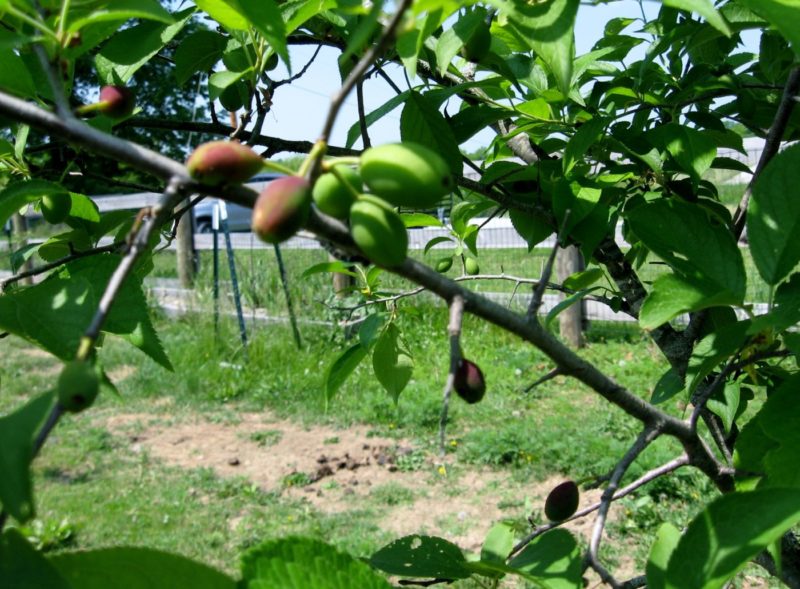
Harvesting and Storing
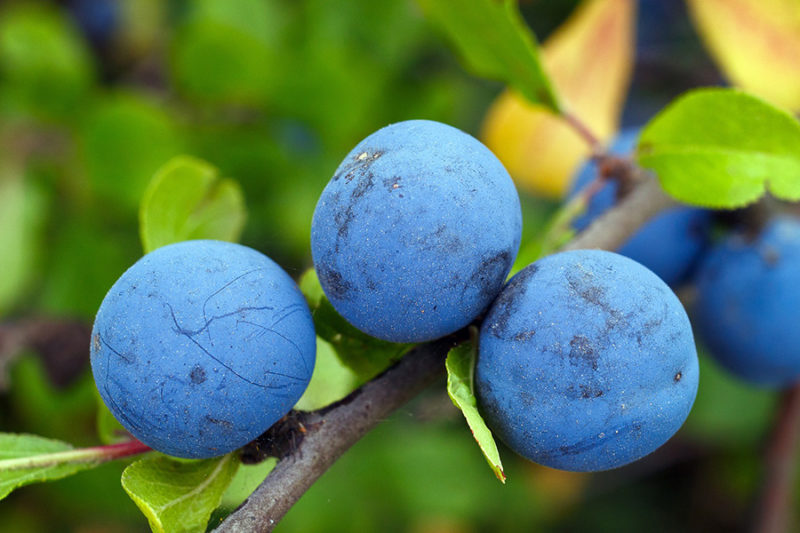
You can tell if your plums are ready to harvest by checking their firmness and flavor. If the plums feel slightly soft, give them the taste test. If they’re sweet, they are ready.
You can also monitor the color of the plums, depending on the variety. This may be easier after your first season when you have had an opportunity to experience the end color.
The fruit will not all ripen at the same time. You will need to check on the progress of each fruit every few days during the growing season.
Store plums in a paper bag on the counter for a few days, or put them in the fridge for up to a week. You can also freeze fresh plums.
Cooking With Plums
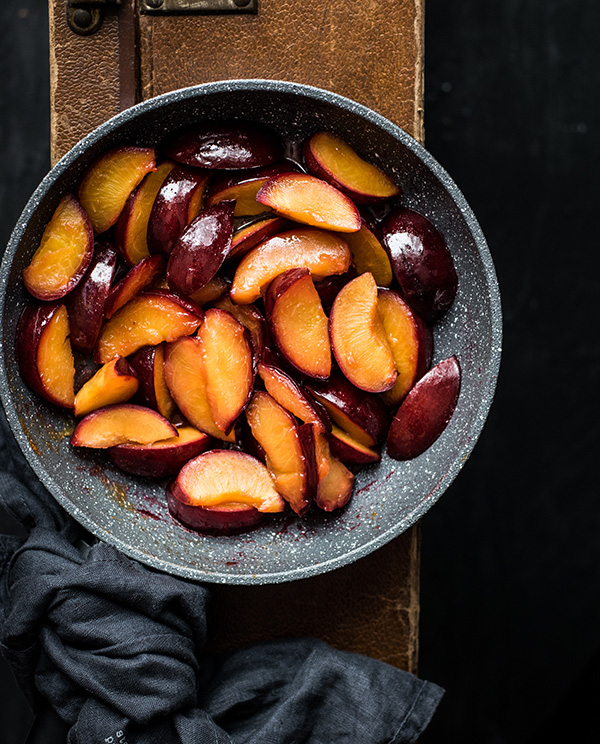
Plums can be used to make all kinds of fun dishes. Have you ever tried making fruit leather? My family particularly loves plum crisp. Plum glaze is great for meats and plum jam makes a nice filling for tarts. Plum jam is particularly tasty, and it’s a good way to use up a bountiful harvest.
What’s your favorite way to eat plums?

